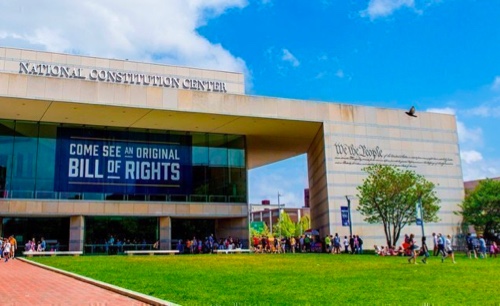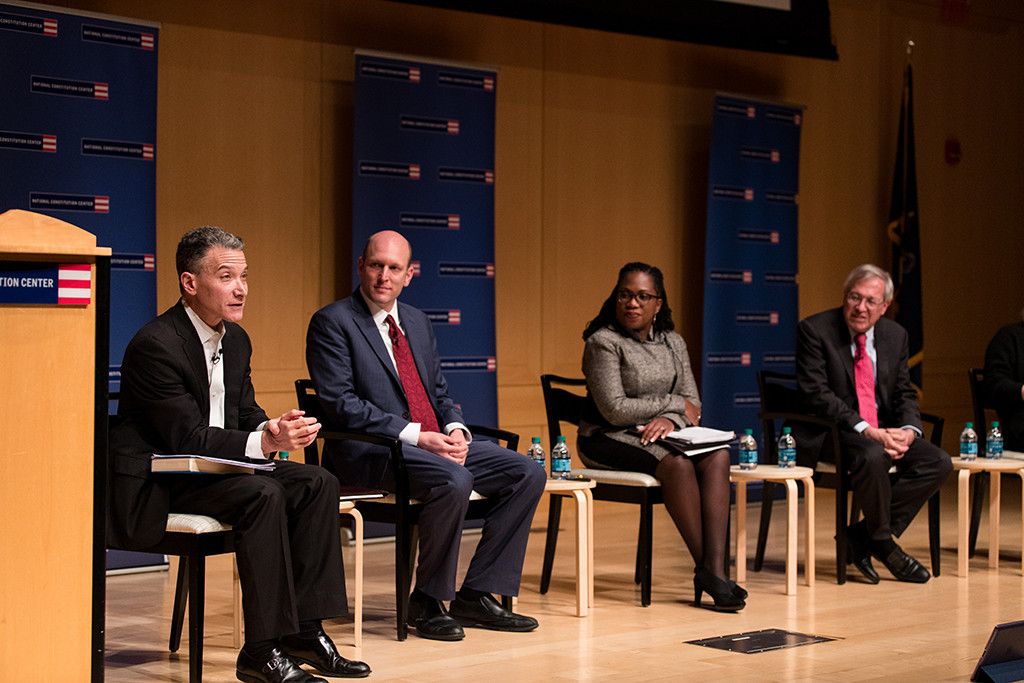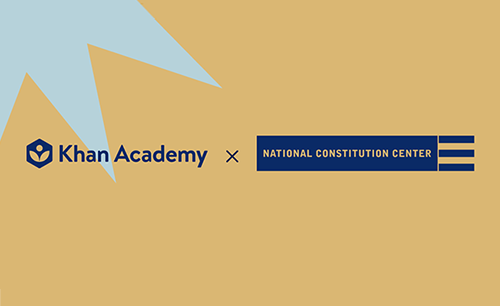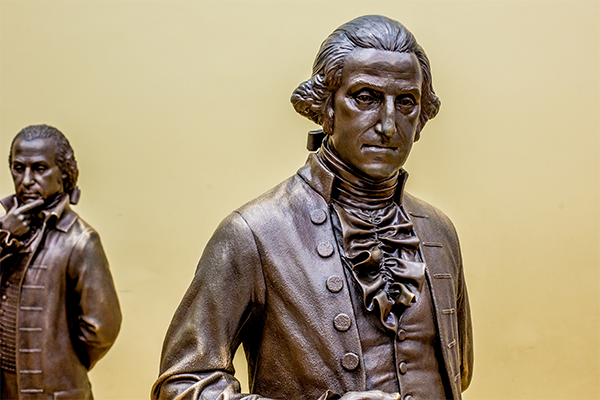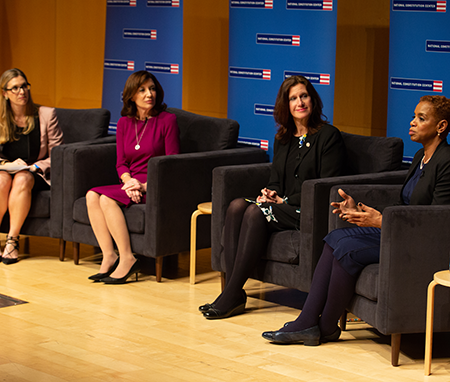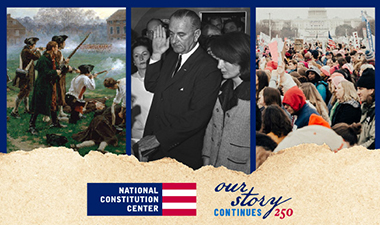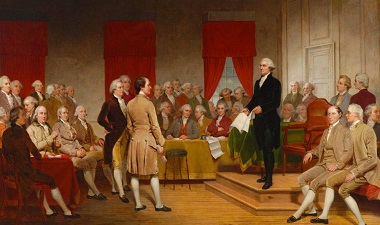New York Times columnist Jamelle Bouie joins award-winning journalist Juan Williams for a conversation on Williams’ new book, New Prize for These Eyes: The Rise of America’s Second Civil Rights Movement, exploring the emergence of a new civil rights era—from the 2008 election of President Obama to the January 6, 2021 attack on the U.S. Capitol. Thomas Donnelly, chief scholar at the National Constitution Center, moderates.
Video
Podcast
Participants
Jamelle Bouie is a columnist for the New York Times and political analyst for CBS News. Prior to the Times, he was chief political correspondent for Slate magazine. And before that, he was a staff writer at The Daily Beast and held fellowships at The American Prospect and The Nation magazine.
Juan Williams is a prizewinning journalist and historian. He is the author of the bestselling book, Eyes on the Prize: America’s Civil Rights Years 1954–1965, which accompanied the PBS series of the same name. He also wrote the landmark biography, Thurgood Marshall: American Revolutionary, as well as the New York Times bestsellers Enough and Muzzled: The Assault on Honest Debate. His new book is New Prize for These Eyes: The Rise of America's Second Civil Rights Movement.
Thomas Donnelly is chief scholar at the National Constitution Center. Prior to joining the Center in 2016, he served as counsel at the Constitutional Accountability Center, as a Climenko Fellow and Lecturer on Law at Harvard Law School, and as a law clerk for Judge Thomas Ambro on the U.S. Court of Appeals for the Third Circuit.
Additional Resources
- Juan Williams, New Prize for These Eyes: The Rise of America’s Second Civil Rights Movement (2025)
- Jamelle Bouie, “Discussing Trayvon Martin, Obama Embraces his Blackness,” The American Prospect (July 19, 2013)
- Jamelle Bouie, opinion columnist, The New York Times
- Civil Rights Movement
- Reconstruction
- Thomas Ricks, Waging a Good War: A Military History of the Civil Rights Movement, 1954-1968 (2022)
Excerpt from interview: Juan Williams notes that Black Lives Matter began after Trayvon Martin's death and, despite criticism, still has over 50% approval.
Juan Williams: A lot of people think Black Lives Matter came into being with George Floyd, you know, dying under the knee of that policeman in Minneapolis. And that's just not true. Obviously, they were there right after Trayvon Martin's murder was acquitted in Florida. And what's interesting here, Tom, is that the women who create Black Lives Matter are not in Florida. They're in California, in Oakland. And what you see is Alicia Garza, Patrisse Cullors, Opal Tometi are online again, the new platform for the second movement. They're online and discussing how people are saying, "Oh, well, you know, he was wearing a hoodie, he's out in the rain, he's talking to his girlfriend," and they're like, and the response from these women and people who are following them is, "Wait a minute, that's a 17 year old coming home with some candy and a drink. What is going on here? Black lives matter. I don't care how he was dressed. I don't care if he had his pants hanging out. He's a young man and his life mattered, Black lives matter."
That's the start. So you're going back here early in the first Obama term. I think Martin is killed in '12. The verdict comes in '13. So that's when Black Lives Matter starts. But then, of course, it continues to grow, Tom, because you have, you know, Tamir rice, Philando Castile, 2016, Eric Garner, Alton Sterling, famously in 14, Michael Brown in Ferguson, Missouri, and I mentioned that one at the very start of the book because this fits with our earlier conversation about Obama. The question is, okay, you got a Black president and you've got race riots taking place in middle America. Is the first Black president going to go? What could he do? What can he say? Maybe he can say something that will resolve this situation in a way that none of his predecessors, all White, could have done. Well, ultimately he doesn't go. But in terms of the story of Black Lives Matter, Black Lives Matter, some of the ladies that I mentioned to you actually go to Ferguson to try to help in that situation. And the question afterwards is, are we now seeing the emergence of an organized, centralized Black Lives Matter movement? And that's when they defer.
They say, no, each community can have its own chapter of Black Lives Matter. They can make their own decisions about their agenda. You know, and what happens, unfortunately, in some cases is a lack of transparency, a lack of accountability with regard to finances, huge amounts of money pouring after the George Floyd murder, you know, tens of millions of dollars, questions about how it's used, how it's spent. But I would just throw in here for all of the attacks, then, that allows it to take place on their legitimacy and on their agenda and their sincere passion. It's still the case that when the George Floyd Black Lives Matter marches take place, most of the people marching are White. Most of the money is coming from White America. And, you know, Trump and the others are trying to say, "Oh, these people are thugs. They're violent, they're threatening." Later, we can see from statistical analysis that's just not true, that 90 plus percent of these marches were peaceful, you know, but again, Black Lives Matter remains to this day. It's not as popular as it once was. Once it was like 2/3 of Americans, you know, thought about the world of Black Lives Matter and the idea of doing something about social justice and racial justice in America and asking questions about how we can deal with this.
But even with Trump coming in, belittling Black Lives Matter, caricaturing them in negative ways, arguing about Black history, you know, what is allowed to be taught to our children, including White children, Trump seems to be arguing, you don't want to make those children feel guilty or bad about themselves because of what happened in the past. Even with all that, Black Lives Matter still has more than 50% approval in this country, and I think lots of people lose touch with that.
Jamelle Bouie contrasts the first civil rights movement's hierarchy with the second's focus on cultural change and structural racism.
Jamelle Bouie: I think it's correct to observe that the first civil rights movement is much more hierarchical and the second is much more diffuse and amorphous. In a lot of ways, I think some of that reflects sort of the environment in which they are operating. The second civil rights movement is operating in a world where there is at least sort of like a surface level commitment to formal racial equality where there is, you know, for the most part, you know, people. There's some amount of like, fair opportunity for like many people, not all people, but many people. Right? It's not, it's a world where making first, like making claims about the existence of racism, you're making claims about sort of like structural racism. You're making claims about, you know, things that are a little harder to see directly as opposed to Jim Crow, but also sort of, the targets of police brutality, for example. There's no central police agency, right? Sort of, it's lots of police departments, it's lots of law enforcement organizations across the entire country.
And it's being sparked by discrete events in different places in the country. So first of all, like the non-hierarchical nature is just like probably a reflection of what is actually driving the activity. But also it seems that the goal, the end in mind, is a little more of a desire for a cultural shift, something that would push the nation to sort of culturally take seriously the existence of, like, legacies of racism and so on and so forth. That's very distinct from the first civil rights movement. And I'm thinking of a great book, Waging a Good War: A Military History of the Civil Rights Movement by Tom Ricks. That first civil rights movement is very much organized, like a disciplined campaign against a, like, discreet and well defined opponent. It's like the Jim Crow system is something very concrete, easy to perceive, with its own legible logic. In that movement, its organizations, its hierarchical structure is very much structured around how do we confront that in a way that will bring the kind of pressure that will undermine it and allow us to kind of wield federal power against it.
And in that way, the first civil rights movement, as Ricks argues, is a lot like a military campaign and sort of operates according to the principles of a military campaign. The strategists of that movement, Bayard Rustin, for example, are thinking about where to stage demonstrations, where to try to generate media attention in a way not unlike a general deciding where to stage an engagement for maximum advantage and gain. So that's sort of how I see the difference there, that it's just, it's two sort of different goals in mind. And in the case of the second civil rights movement, in the case of the past 10 to 15 years, it's something much, much broader than simply trying to take down the government of Mississippi, right? Like, it's something a little more amorphous, frankly. It's like, if you can successfully persuade a lot of people that there is something called structural racial discrimination, and to the credit of sort of the Black Lives Matter movement successfully persuaded many Americans that there is something called structural racial discrimination. It's like, okay, you've done that. Then it's sort of like, well, what's next? What's the kind of concrete action you have to take? And I think that one of the downsides of the more horizontal organization, you might say, of the second civil rights movement is that having won a cultural victory, it was hard to consolidate that into, like, a durable political one.
Full Transcript
View Transcript (PDF)
Stay Connected and Learn More
- Questions or comments about the show? Email us at [email protected]
- Continue the conversation by following us on social media @ConstitutionCtr.
- Sign up to receive Constitution Weekly, our email roundup of constitutional news and debate.
- Subscribe, rate, and review wherever you listen.
- Join us for an upcoming live program or watch recordings on YouTube.
- Support our important work.
